Sell or return
Many British cars must leave Afghanistan after a comprehensive overhaul and recovery cycle in order for all of them to be in good condition.
The article on the final stages of the Herrick operation is analyzed as military equipment stored in Camp Bastion's British headquarters will be destroyed or removed from the theater of military operations back to the UK.
In March, 2014, the UK closed or transferred the last three operational bases in Helmand province in southern Afghanistan, and in May, the last observation post Sterga 2 was closed, after which only the Camp Bastion base remained at the disposal of the British. Currently, the withdrawal of troops and equipment to headquarters has been completed, and the Helmand task force has been dissolved; now all efforts are directed to the withdrawal of all technology by the end of 2014 of the year.
Lt. Col. Robert Cosgrove of the REME engineering and repair service, who had been planning for two years and is now leading the work on the withdrawal, said he predicted a return of about 5500 containers back to the UK from the total number of 9800 units. The remaining containers must be decommissioned or used in theaters before the end of 2014.
“45 percent will be sent back, and 55 percent will be written off or used on theaters. Some of these 9800 are food and fuel, etc., but if we are not going to send them back or use them, there are three basic ways we can use to write off. ”
These methods include the sale of inventories in the local market, the sale in the international market and the transfer of them as aid, everything that cannot be sold will be destroyed. Non-military equipment intended for sale is regulated through the commercial company Agility. This includes tents and places of temporary residence, office, laundry and sanitary stations, as well as the remaining tarpaulin or empty standard twenty-foot TEU containers and even construction equipment.
Work on the redeployment began in October 2012, from that time until the end of 2013, 2025 TEU containers were returned to the UK, one third of the total. The remaining two three must return to the end of 2014 of the year.
Working condition
The process of returning the equipment back starts with the units that are responsible for packing their equipment. All the organizations involved follow the so-called POGO process (confirmation of working condition) so that all equipment and equipment returns in the best condition and in the most economical way in accordance with the rational expenditure of funds.
Cosgrove said that having an accurate inventory of goods and stocks in the area of the operation means that if there are any additional equipment, equipment and supplies in place, all this is not sent from the UK. This reduces the amount of work by using field reserves and eliminating the need to return additional items that were sent.
The withdrawal of troops is based on the withdrawal of combat capabilities, when the tactical situation allows. This means that the volume of material values that are withdrawn from places is most likely subject to ups and downs; this is not a constant flow of machines or sets of equipment.
One of the key organizations in the POGO process for the withdrawal of troop vehicles from Afghanistan is the theater support equipment group at the Theater Equipment Support Group (TESG). Previously, she had the task of providing vehicles in the theater of operations according to the measures taken to assist the troops, but at present she is working mainly on redeployment, preparing vehicles for withdrawal from the theater equipment Return System (TERS) military equipment.
After the PJHQ (Permanent Joint HQ) Permanent Joint Ministry of Defense made a decision to withdraw the property, the unit is informed that it has 21 day to clean up their vehicles, remove them and register them with additional complete equipment, for example, Bowman communications, cameras and electronic countermeasures kits.
Next, the vehicle enters the POGO process. It enters the ERHF Equipment Repair Center for three days to bring it to the appropriate standard. The ERHF Center checks the purity and readiness of documents for onward transmission.
ERHF is associated with the TERS system relocation coordinator in the TESG group, which has 30 days to bring the machine to a standard output from the theater (TXS) of the 2 Level. All additional equipment is removed and the machine is classified as “fully compliant A2”.
Defect Search
The thirty-day period is sufficient for the RESE engineering service personnel in the TESG group to inspect and diagnose faults, order spare parts within five days and then take the car to the workshop and hand it over to the TXS repair platoon. If parts need to be ordered in the UK, then it basically takes 7-12 days: picking, packing, entering into a database and sending it to a TVD. After the engineers repair the car, it is once again inspected for readiness for transfer to the ERHF Center and the next step in the home withdrawal chain.
Captain Moray Watson from the TESG group said: “All of our guys are trained on at least two platforms, either through formal training in special courses to get qualifications on this platform, or by working alongside someone who has experience and qualification in this field. We can always send people to alternative types of machines or, if we have a request from the field offices, transfer them to the department for help.
The numbers provided by TESG in January 2014 of the year show that the relocation target at the beginning of the year was the 3371 machine, the 1643 machines had already been returned to Britain and 1728 still had to be sent. The latest number includes 512 armored vehicles, 750 logistics vehicles and 466 units of other major equipment consisting of non-transport components, such as generators.
According to TESG, from 16 in October 2013 of the year to January of 2014, the 201 task for the redeployment of machines and main equipment (VaME) and 416 of conventional repair tasks was completed to help military units. The Ministry of Defense reported that 30% VaME and 62,8% TEU containers, which had either left the theater or were on the way, were redeployed on 63,8 on April, inclusive.
Although TESG is responsible for setting the 2 Level, it can also perform more complex 3 Level repairs, for example, when it comes to replacing engines and bridges. After the TESG Center, the vehicles return to the EHRF for 9 days and then go to the Joint Movement Unit (JMU) for a period of three to five days before being transferred by air.
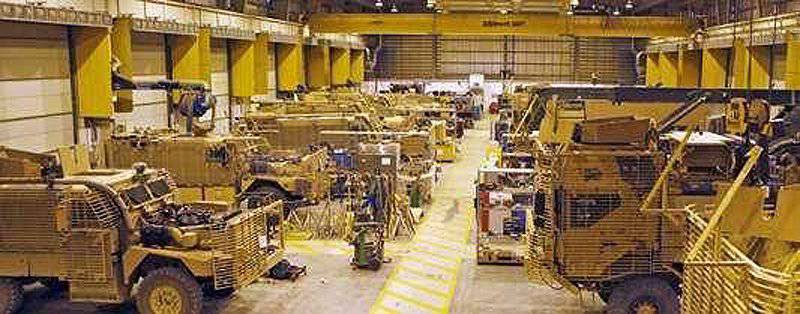
After doing the hard work of securing the forward bases, some logistic (service of the rear) machines will return to the UK, first by land route, and then by sea

The machines are prepared by both TESG and DSG organizations in order to bring them up to readiness standards. Capacities organized in Afghanistan and not in the UK are considered a more rational option.
Strong influence
In addition to Bastion's TESG, the Defense Support Group (DSG), a logistics organization operating at the site of the TESG center, has significant influence. It provides logistical support to the fleet and carries out in-depth repairs on a two-year cycle. The organization was selected in 2010 and was then fully operational, replacing contractor Kellogg, Brown & Root as a service provider to service machines for immediate needs.
At the end of 2013, the DSG received a one-year contract (until the end of 2014) to provide technical support for the withdrawal of the machines.
Bastion's DSG General Manager Steve Faulkner said: “There will still be some recovery needs, but they have dropped significantly from more than 70 platforms in October to 12 platforms in January.”
At that time, the DSG hangar from the 26 boxes for the machines was left 12 working boxes.
Faulkner added that the DSG’s presence will continue to the very end, even if the reduction accelerates: “Some modest opportunities will remain after most of the guys go home. The Cat 320 generator maintenance team will remain, providing the entire Bastion with power and air conditioning. We have a couple of guys serving the reconnaissance and observation system, so they will also remain. ”
The recovery process for machines is performed within 60 days. On the first day, the platform is accepted, an inspection is carried out, materials are ordered, it is placed on an open area and entered into a schedule.
21 is given for the supply of spare parts a day, while Faulkner reported that 70-80% of materials come in these terms, with the exception of special equipment that has not been ordered before. Then, on the thirtieth day, the platform enters the workshop with all the available materials and the work begins, which is completed by the end of the 60-day period.
In January, DSG had 113 people in theaters dealing with various evacuation, cargo, construction, earth moving, loading facilities, Cat 257, Cat 434 and Cat 938 power plants of various sizes plus tankers, generators and armored vehicles.
"We are not engaged in Foxhound, because they recently arrived here, so by the time the car comes to its two-year cycle, we will go home," said Faulkner.
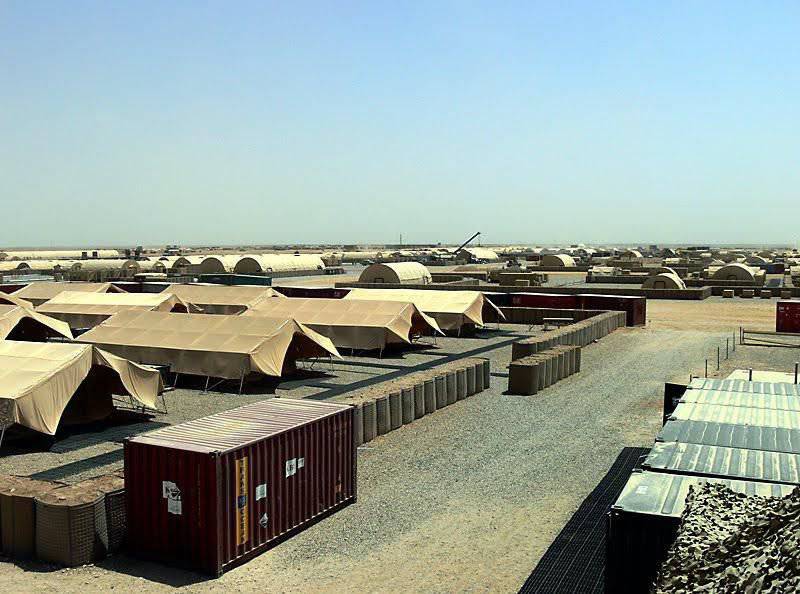
All types of kits are stored at Bastion, since the PJHQ Permanent Joint Headquarters decides that it is economically beneficial to send to the UK or dispose of it on site.
Recovery game
Decisions about which equipment enters the regeneration process are made “platform-wide” and submitted to PJHQ, which coordinates financing of machines to be repaired, with the Ministry of Finance.
Further work is assigned to the park manager, who organizes an order to perform the work to the appropriate unit, which must transfer the car to the restoration. The unit donates the platform to the Vehicle Replenishment Section (VRS) group, which provides a replacement from its restoration fund.
"VRS further tells DSG that the platform is available, so the DSG organization takes it, it goes through a cycle in 60 days and then we send it back to VRS, where it enters the reserve of this group."
Faulkner said that the main advantage of the DSG, which performs field recovery work, is the time and money saved due to the fact that the material part is not sent home. Instead of four cars that are under repair and in the cycle of transportation, only two are needed - one under repair and one in operation.
“Since you do not send the platforms home, you simply save money and shorten the repair cycle in the UK - about three to four months, including transportation to Britain and back. Due to the fact that you have production facilities, you save money and get a car ready for battle in less time. Here we can do everything except for a complete overhaul, when there is a complete disassembly and dismantling of all subsystems. But here, however, it is possible to replace all subsystems. ”
Operational Planning Group The Operational Planning Group - Redeployment (OPGR) is the management that controls all major organizations in the field of property withdrawal and which represents the fleet's capabilities, the required field capacities and the cost of redeployment or decommissioning.
This group determines what goes back through the air and what comes back by land. It depends on factors such as, for example, whether this property is secret, attractive to criminal or terrorist organizations, or urgently necessary for emergency situations. OPGR also analyzes what will be cheaper - to destroy something in the theater or to relocate.
The OPGR team is assisted by operational analysts from PJHQ, who look at the scope of the task and the volume of the kit on the theater. They estimate the capacity of the roads and all ground routes of communication (GLOC) plus the number of available aircraft and the capacity of the nodes (such sites as, for example, Brize Norton and Bastion) and how much property can be transported through them.
Alternative routes
Each of the different GLOC or air paths has a different cost per ISO container, which is often the determining factor. Studies by PJHQ have shown that the cost of transporting through Pakistan costs about 6000 pounds per ISO container and this is the cheapest route.
But there are certain problems on this route, so the northern alternative route through the republics of Central Asia was also used. Cosgrove explained: “The reason we have several routes is because we have systems that we would like to send back to the UK directly for security reasons. This gives us a rational decision on which routes we are going to take due to price changes over time, as they inevitably change. However, the cost of shipping containers through the northern route is almost 12 000 pounds for each container.
“However, it gives us some flexibility when we go through ups and downs. This is not a constant flow and we are able to maneuver between the number of routes. Therefore, the withdrawal of property from theaters is not a deterrent — we always have enough opportunities to overcome peak situations. ”
"In particular, goods transported on land routes to the north through the Central Asian republics or to the south through Pakistan are classified as less valuable property, shipped in large quantities."
"This does not mean that we will not send cars, we will of course, but they will be more logistic than armored cars."
Strategic assets such as, for example, new armored combat vehicles, which cannot be transported over land by commercial transport, constitute the majority of air transport.
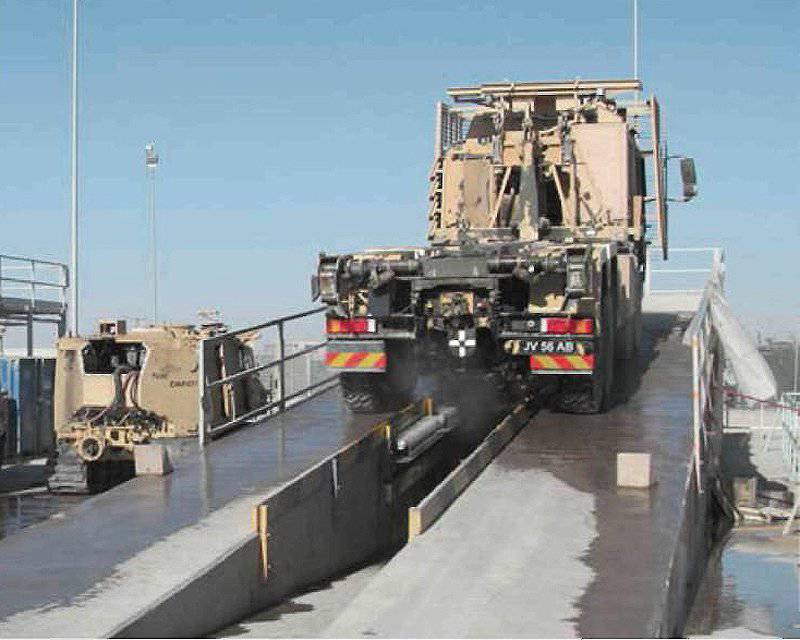
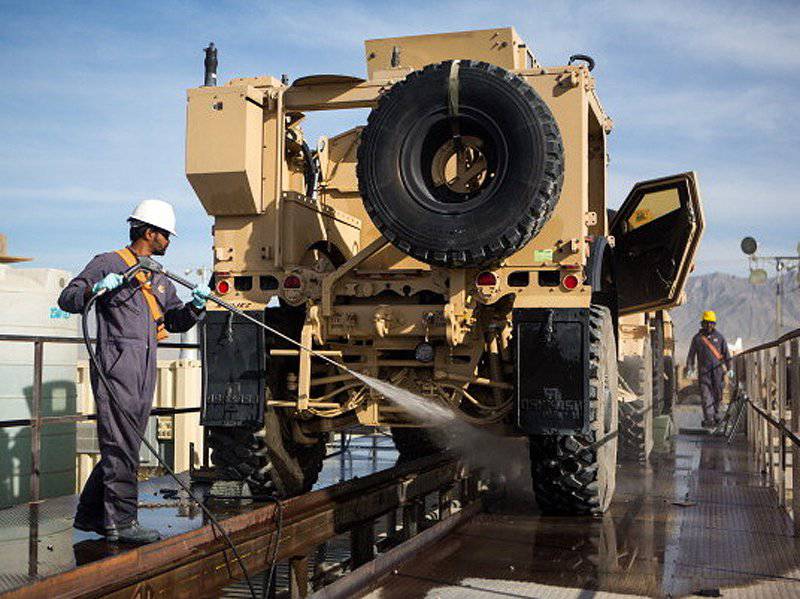
Machines are washed with chemicals before shipping. These strict cleaning rules must be strictly followed.
Foxhound light patrol vehicles from the British contingent before being sent home by plane
Air transport
For transportation of vehicles and other property used aircraft C-17, C-130, An-124 and commercial Boeing 747. A report by the Committee of Defense of the House of Commons, published in May, states that “about two-thirds of the main equipment transported to date” was transported by air, and a quarter removed by a “combined route” that includes a flight to the country of the Persian Gulf and then shipping to the UK by sea. ”
The report also says that the Ministry of Defense informed the committee that the net additional costs of delivering major equipment by air "were estimated at almost 100 million pounds, which will be funded from the special reserve of the Ministry of Finance."
The Royal Air Force C-17 transports have an 18 pallet capacity (cargo pallets), they have already been paid and are used to transport approximately 50-60 vehicles once a month. This is a big load, but the deployment within the framework of Operation Herrick is the main objective of the C-17 fleet, and the intensity depends on the volume of property derived from the theater of operations according to the PJHQ decision.
Antonov's aircraft are used to transfer platforms with combat damage, since in the UK it is especially demanding of fastening systems for vehicles and therefore it would be problematic to move the damaged property. In this case, the An-124 offers a large capacity and has a crane for lifting machines in situations where the floor of the C-17 may be damaged. Antonov aircraft have space for the 32 pallet, but are used less frequently because they are more expensive than the 747 model aircraft. Under contracts with NATO, they are deployed around 11 once a year.
747 Boeings are used mostly for the transport of 42 cargoes with aircraft pallets and fly approximately 15 once a month. They can also be used to transport light vehicles, such as Land Rover and equipment, such as generators. The aircraft are contracted so that each time they are used with maximum efficiency in order to take as much cargo as possible from the C-17 transports.
Depending on the temperature, the C-130 can lift six or seven aircraft pallets with equipment. This is about 10 tons of cargo, which may consist of small vehicles, such as a pair of armored vehicles. However, these aircraft are mainly used for the transport of goods within the theater.
There are various air routes that military property can take to the UK. Due to their secrecy, all combat vehicles, along with important equipment, are sent only by air. This can be done in two ways, either directly from Camp Bastion to Herrick’s Worminster exchange point, or by plane to junction points in the Middle East, and then by a horizontal cargo handling vessel (RO-RO type) to Marchwood or via German Hannover.
On a pile of garbage
Any property that must be disposed of is transferred to the so-called “military debris” zone based on Bastion. It works as a processing center with lines for metal, wool and plastic. All that comes to this center, everything is destroyed and deducted from the balance. Nothing should be left of which an improvised explosive device could be made. This includes items that contain chemicals, such as refrigerators, freezers or fire extinguishers. Bulletproof glass is cut by a plasma torch, also comes in with wire, trellis screens, cars, towers and rubber tracks from Warthog all-terrain vehicles.
From July 2013 to January 2014, the TEU 756 containers were destroyed and another 729 is waiting for its disposal until the end of the year. Some items cannot be disposed of locally, such as lithium batteries, which are potentially dangerous to the environment, they must be sent to the UK for recycling.
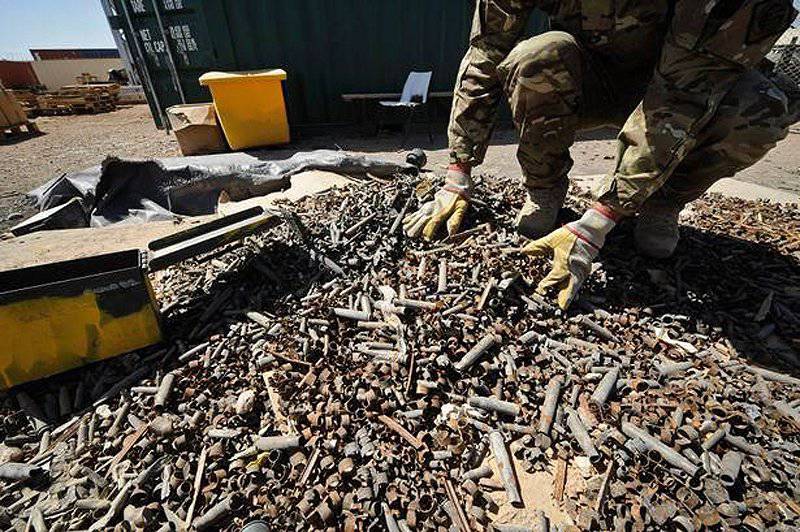
In a special furnace on the territory of the base ammunition for small arms is burned. weaponsbecause this process allows you to get valuable waste copper and lead. Weather conditions in Afghanistan do not allow to store such ammunition for a long time. They have a short shelf life, only six months, so most of them become unusable or unprofitable for transportation. Nonferrous metals accumulated after the destruction of ammunition can be sold back to the UK at a cost of 43 pounds per container. The melting furnace provides an average of 2,5 tons of metal per day, but since January 2014, productivity has been increased to 4 tons per day.
You can burn ammunition from 12,7-mm to 5,56-m in the furnace, and rockets and ammunition of larger caliber are destroyed on special platforms outside the Bastion base.
Materials used:
www.shephardmedia.com
www.en.wikipedia.org
www.armedforces.co.uk
www.ru.wikipedia.org
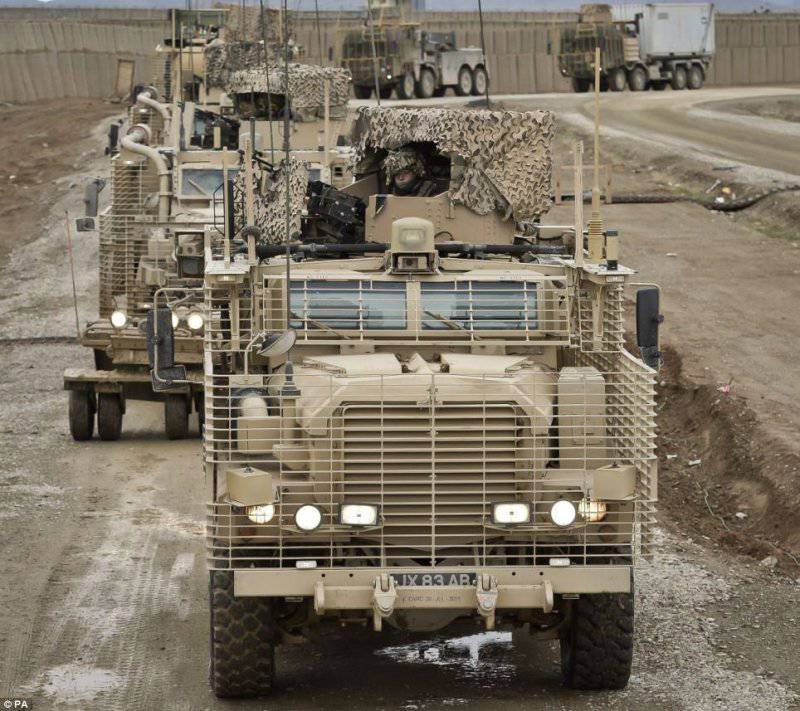
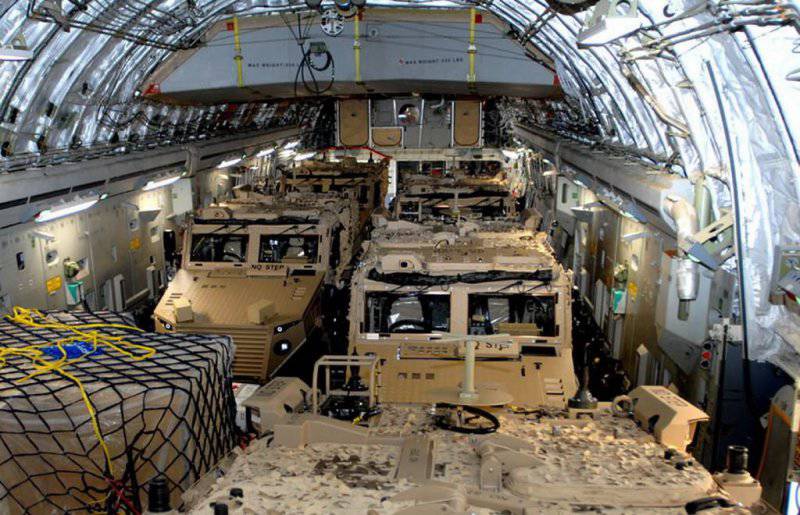
Information